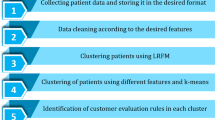Abstract
Medical consumable usage is ineluctable in treatment process. High consumable cost not only brings pressure to the patients and their families, but also reduces the performance of hospital operation management. Therefore, precise medical consumable usage management is very important to the hospital. Large amounts of data accumulated over the years in hospital provide a resource for pattern and rule discovery. A medical consumable usage control method based on Canopy_K-means and Weighted Association Rules Mining (WARM) is proposed in this paper. Firstly, Canopy algorithm is used to get rough clusters; Secondly, K-means algorithm is used to get accurate clusters; Thirdly, ARM and WARM are used to discover rules between disease and consumable among a cluster; In the Fourth, the consumable usage control method in daily requisition has been designed. Half-year data from an A-level hospital in Shanghai have been studied, the results show that WARM can help to find rules between disease and consumable, and the control method based on WARM is feasible to apply.

Similar content being viewed by others
References
Abdullah Z, Herawan T, Deris MM (2011) An alternative measure for mining weighted least association rule and its framework. In: International conference on software engineering and computer systems (ICSECS), vol 180, pp 480–494
Cao Y, Wang Y, He H, Yanf B, Gui W (2017) Intelligent scheduling in pre-burdening of iron ore: Canopy-Kmeans clustering algorithm and combinatorial optimization. Control Theory Appl 34:947–955
Chasseigne V, Leguelinel-Blache G, Nguyen TL, Tayrac R, Prudhomme M, Kinowski JM, Costa P (2018) Assessing the costs of disposable and reusable supplies wasted during surgeries. Int J Surg 53:18–23
Fu H, Li L, Yip W (2018) Intended and unintended impacts of price changes for drugs and medical services: evidence from China. Soc Sci Med 211:114–122
Gupta R, Gupta KK, Jain BR, Garg RK (2007) Abc and ved analysis in medical stores inventory control. Med J Armed Forces India 63:325–327
Jing W, Guanglian X (2011) Research on the factors affecting the adoption of high value medical consumes in less developed areas of china. Value Health 14:A173–A174
Lin H, Li Q, Xu X, Li P (2019) Optimal arrangement of the pulmonary interventional surgeries considering timely distribution of medical consumables. J Comb Optim 37:271–285
Muyeba M, Khan MS, Coenen F (2009) Fuzzy weighted association rule mining with weighted support and confidence framework. In: New frontiers in applied data mining, PAKDD 2008, vol 5433, pp 49–61
Pears R, Koh YS (2012) Weighted association rule mining using particle swarm optimization. In: New frontiers in applied data mining, PAKDD 2011, vol 7104, pp 327–338
Rosales CR, Magazine M, Rao U (2015) The 2bin system for controlling medical supplies at point-of-use. Eur J Oper Res 243:271–280
Soni S, Vyas OP (2011) Performance evaluation of weighted associative classifier in health care data mining and building fuzzy weighted associative classifier. In: Advances in parallel distributed computing, PDCTA 2011, vol 203, pp 224–237
Yang Y, Yan C (2019) Pattern of consumables usage in hospital departments based on clustering and association rules. Chin Hosp Manag 39:20–27
Yang Y, Luo S, Fan J, Zhou X, Fu C, Tang G (2019) Study on specialist outpatient matching appointment and the balance matching model. J Comb Optim 37:20–39
Zhou QS, Olsen TL (2018) Rotating the medical supplies for emergency response: a simulation based approach. Int J Prod Econ 196:1–11
Acknowledgements
This article was funded by Research Center of Resource Recycling Science and Engineering, Shanghai Polytechnic University and Gaoyuan Discipline of Shanghai—Environmental Science and Engineering (Resource Recycling Science and Engineering). This paper is an achievement of Project “Study of the operational mechanism and its optimization of resource management in surgical operations (71371120)” supported by National Natural Science Foundation of China. This research was supported by Shanghai Science Committee of China under Grant No. 17495810503.
Author information
Authors and Affiliations
Corresponding author
Additional information
Publisher's Note
Springer Nature remains neutral with regard to jurisdictional claims in published maps and institutional affiliations.
A Appendix: Canopy algorithm
A Appendix: Canopy algorithm

Rights and permissions
About this article
Cite this article
Yang, Y., Wu, H. & Yan, C. Medical consumable usage control based on Canopy_K-means clustering and WARM. J Comb Optim 42, 722–739 (2021). https://doi.org/10.1007/s10878-019-00468-0
Published:
Issue Date:
DOI: https://doi.org/10.1007/s10878-019-00468-0




